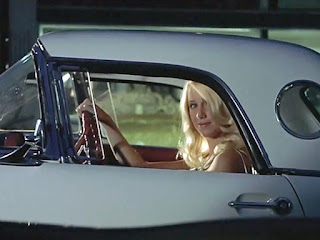‘American Graffiti is not only a great movie but a brilliant work of
historical fiction; no sociological treatise could duplicate the movie’s
success in remembering exactly how it was to be alive at that cultural instant.’
– Roger Ebert, August 11, 1973.[1]
Ford Thunderbirds. Rock ‘n’ roll. The high school
hop. I’m describing the 1950s right? Wrong. This is 1962 and we’re in Modesto,
California.
 Given the popular images that come to mind when one
thinks of the swinging sixties, you’d be forgiven for thinking that American Graffiti was just another
product of misinformed nostalgia. I mean where are the hippies and Cold War
overtones? By all means, it has a great soundtrack, probably the best ever put
to screen, but where are the Beatles; the Stones; the Doors? This wasn’t the
sixties man, Lucas must have gotten the year wrong. I get it. I do. But the
sixties did not become ‘The Sixties’ over night; it wasn’t as seamless as that.
Given the popular images that come to mind when one
thinks of the swinging sixties, you’d be forgiven for thinking that American Graffiti was just another
product of misinformed nostalgia. I mean where are the hippies and Cold War
overtones? By all means, it has a great soundtrack, probably the best ever put
to screen, but where are the Beatles; the Stones; the Doors? This wasn’t the
sixties man, Lucas must have gotten the year wrong. I get it. I do. But the
sixties did not become ‘The Sixties’ over night; it wasn’t as seamless as that.
People often question when the sixties actually
began. Was it as simple as Jan 1, 1960? Was it the Cuban Missile Crisis in
October, 1962? Was it the assassination of JFK on 22 November, 1963? For me
it’s the latter. JFK’s assassination truly set the tone for what was to come.
Popularly, the sixties was the decade of sex, drugs and rock ‘n’ roll. It was
the era of flower power and free love. If ever there was a time to be alive,
this was it.
We know better.
The late, great Robin Williams once said: ‘if you
remember the sixties, you weren’t there.’ Ask yourself why. Yes, the 1960s was
all of the above. It was also a decade clouded by the Vietnam War, social
unrest, and the persistent threat of nuclear annihilation. Given the choice, was it a decade that
anyone would have wanted to remember?
American
Graffiti takes us back to the beginning of the decade. It’s
a world that looks alien to anyone who has a preconceived notion of what the
sixties looked like. Here was a self-contained world of innocence. Here were a
group of teenagers cruising the streets in their T-Birds and Chevy Impala’s,
rocking at the high school hop, and chasing angelic blondes.
It just goes to show how much can change in a year.
‘Rock ‘n’ roll’s been going downhill ever since
Buddy Holly died.’[2]
By Jordan Newton
[1]
Roger Ebert, ‘American Graffiti’, Roger Ebert.com, (1973), http://www.rogerebert.com/reviews/american-graffiti-1973,
(Accessed 17 November 2016)
[2]
George Lucas, American Graffiti, 1973







No comments:
Post a Comment